Cases in subdisciplines of craniomaxillofacial surgery—corrective jaw surgery, maxillofacial trauma, temporomandibular joint/skull base, jaw reconstruction, and postablative reconstruction—illustrate the ease of use, cost effectiveness, and superior results that can be achieved when using computer-assisted design and 3D volumetric analysis in preoperative surgical planning. This article discusses the materials and methods needed to plan cases, illustrates implementation of guides and implants, and describes postoperative analysis in relation to the virtually planned surgery.
Three dimensional (3D) facial analysis and virtual surgical simulation has revolutionized the way surgeons diagnose, treat, and reconstruct head and neck diseases and defects. In our modern computer era, digital planning has been the standard in architectural design, engineering, and biomedical fabrication; this trend has recently made an impact on clinical medicine and surgery. In all aspects of surgery, proper planning facilitates more predictable operations and operative results, but prior to the use of virtual planning, much of this relied on inaccurate surgical models, intraoperative trial and error, and 2-dimensional (2D) imaging. This process increases operative time, operator frustration, and postoperative inaccuracies.
The goal of this article is to illustrate the ease with which virtual surgery and computer-assisted design can be integrated into one’s armamentarium, and benefit the surgeon and the patient with more precise surgical planning, decreased operating time, and creation of accurate postoperative results compared with traditional craniomaxillofacial surgical treatment planning. At their institution, the authors have reliably achieved excellent results in corrective surgery of the jaws, maxillofacial trauma, temporomandibular joint reconstruction, skull base surgery, jaw reconstruction, head and neck oncologic surgery, and postablative reconstruction. For the 90+ cases the authors have virtually planned and completed, the cost has ranged from 2000 to 4000 dollars per case depending on the amount of templates and implants fabricated. These techniques have become the authors’ preferred method for complex craniomaxillofacial surgery and reconstruction.
Corrective jaw surgery
Orthognathic surgery is widely used in the correction of craniomaxillofacial deformities. There is a rich history of preoperative planning and evolution of surgical techniques dating back to the 1800s and, for the most part, the basis of these procedures has not changed in the last several decades. Traditional planning for correction of skeletal facial deformities is complex, and requires several sets of patient data to establish the correct diagnosis and treatment plan. Facial and intraoral photographs, lateral cephalogram, orthopantomogram, and articulated dental casts are necessary to begin this process. After evaluating the aforementioned data, most surgeons digitally or manually trace the lateral cephalogram and plan sagittal maxillomandibular movements based on correction of predefined cephalometric measurements. Correction of yaw and roll, however, can be much more difficult and generally relies on precise dental cast mounting, clinical examination, and facial/intraoral photographs. After determining the amount of correction of the maxilla and mandible in all 3 planes, “surgery” on the dental models is performed to replicate the intraoperative repositioning of the jaws, and interocclusal splints are fabricated with acrylic. These splints are essential in repositioning the jaws, especially when maxillary and mandibular surgeries are performed together, but their accuracy is dependent on several factors. Because most of these movements are in the 1- to 10-mm range, small errors and discrepancies in each step of the workup can compound and lead to inaccurate and unpredictable final results. Facebow records, interocclusal records, deformation of dental impression material, inaccurate mounting, shrinkage of acrylic splints, inaccurate placement of line markings, and small discrepancies in model surgery all lead to some degree of error, rendering the exact measurements in movement planning not totally predictive of the end result. Facebow records rely on the arc of rotation of the mandible when transferred, but the hinge axis is connected to the maxillary arm of dental articulators. Complex facial asymmetries are nearly impossible to correct in 2D planning, and many times asymmetries are induced, due to the compounding of small errors throughout the planning and model surgery process.
In an operation whereby planning in millimeter increments is so important, computer-assisted virtual surgery proves to be a valuable asset in producing more predictable results. By eliminating several sources of error, one can plan more precisely and achieve more accurate movements. The first step in this process involves acquisition of the appropriate data set. Noncontrast maxillofacial computed tomography (CT) is acquired while the patient occludes in maximum intercuspation. To ensure an accurate transfer of the patient’s occlusion to the radiographic data, a facebow bite jig is fabricated by impressing the dentition with hard-set acrylic. When set, this model provides an accurate representation of the patient’s bite. The patient is sent to the CT scanner with the jig in place and 1-mm cuts or high-resolution CT is acquired (see case 1 , Figs. 1 A and 2 A). A gyroscope is then attached to the facebow jig to measure the natural head position, yaw, pitch, and roll, thus replacing the need for facebow transfer and dental cast articulation. The CT scan, along with traditional gypsum maxillary and mandibular dental models, is sent to the desired modeling company. The dental casts are laser scanned and digitally merged into the maxillofacial CT to allow for accurate representation of the dentition without scatter artifact. Treatment planning is completed via the software using the 3D facial reconstructions of the CT scan. Accurate correction of yaw, pitch, and roll as well as midline correction and facial heights can be completed in all 3 planes of space. Using plain cephalometric films as in traditional orthognathic treatment planning only allows for two dimensional correction, whereas all other planes of space are evaluated using clinical photographs and examination. 3D cephalometry allows the surgeon to view the skeletal defects in relation to the entire facial skeleton.
Fig. 3 shows a 17-year-old otherwise healthy female referred for surgical correction of a skeletal class III occlusion and vertical maxillary excess.
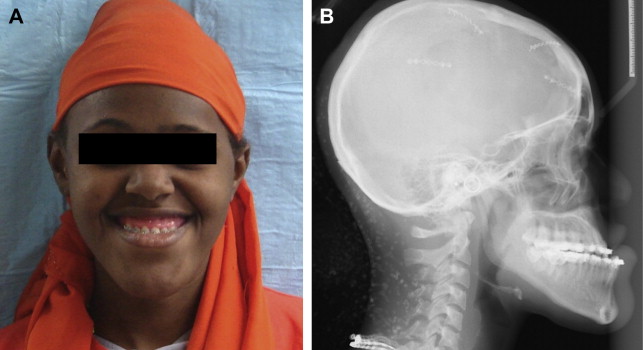
Initial steps in treatment planning as already described call for acquiring a high-resolution CT while the patient wears an interocclusal record with an acrylic facebow (see Fig. 1 A), and measuring natural head position with a gyroscopic attachment to the facebow bite jig (see Fig. 1 B). After acquisition of the CT scan (see Fig. 2 A), the laser scanned dental models are integrated into the radiographic data and the planning phase can begin. The head position as measured by the gyroscope allows for calibration of the 3D movements in the virtual software, and cephalometric landmarks can be marked and referenced. The central condylar hinge axis is virtually applied to the mandible and assists in accurate autorotation (see Fig. 2 B). The surgical movements are then planned via Internet meeting with the surgeons and biomedical engineer from the modeling company.
Lefort I and sagittal split osteotomies are performed virtually, and the correction of the midline discrepancies, vertical excess, and prognathism are completed. Correction of yaw, pitch, and roll are confirmed by numerical leveling of the 3 axes compared with the preoperative gyroscopic facebow measurements. The osteotomized bony segments are color coded ( Fig. 4 ), and can be moved in all 3 planes of the space with the computer mouse. Once the ideal virtual surgery is performed, the plan is submitted and the modeling phase can begin. The modeling company (Medical Modeling Inc, Golden, CO) fabricates stereolithographic models of the skull as well as intermediate ( Fig. 5 A) and final (see Fig. 5 B) occlusal splints.
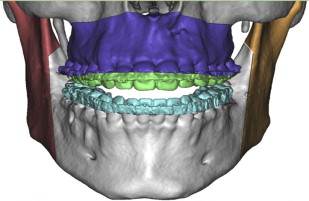
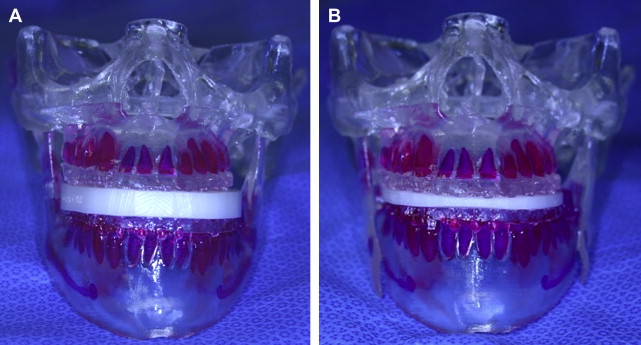
In the surgical phase, the osteotomies are performed as planned: Lefort I followed by application of the intermediate splint and maxillomandibular fixation (MMF), and microplate fixation to the vertical facial buttresses. Once the maxilla is fixated, the MMF is released and the mandibular sagittal split osteotomies are performed, placed into final occlusion with the final occlusal splint, and the mandibular segments are fixated with sagittal plates and screws. The desired occlusion and skeletal changes were successfully achieved ( Fig. 6 ).
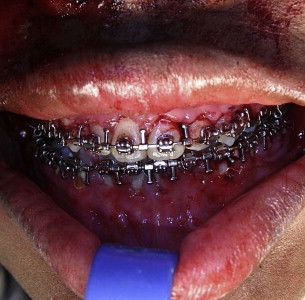
The fourth and final stage of computer-assisted surgery may be the most important. The evaluation phase begins in the postoperative period, and allows the surgeon to compare the predicted results with the actual outcome. Clinically the correction of this patient’s vertical maxillary excess, midface deficiency, and mandibular prognathism is evident ( Fig. 7 ), but does it correlate with the virtual surgery and treatment plan? A postoperative CT is acquired and sent to the modeling company. This CT scan is rendered into a 3D image and overlaid against the 3D image of the treatment plan. Here, the surgeon can see how accurate the planned movements are reflected in the actual result. The overlay is color-shaded to provide a visual representation of the accuracy, thus allowing the surgeon to identify both anatomic areas of error and the cause of these inaccuracies.
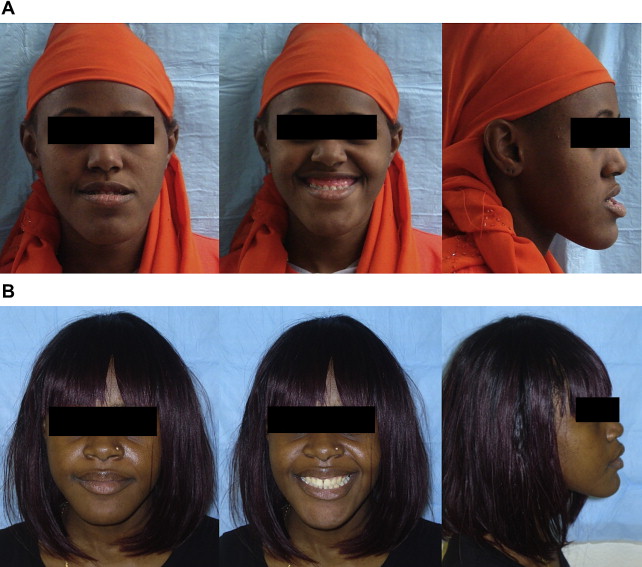
A 32-year-old woman with a history of right-sided mandibular condylar hyperplasia presents with a chief complaint of facial asymmetry ( Fig. 8 ).
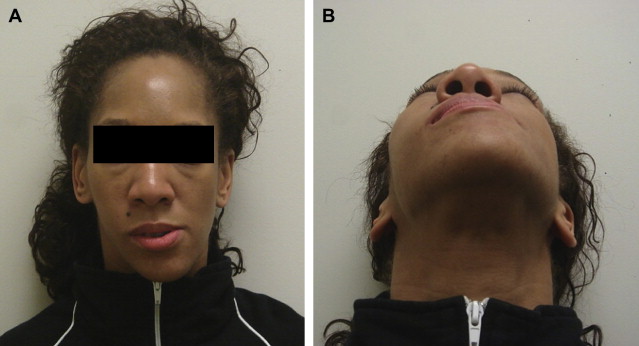
After acquisition of the appropriate data as described previously, the Web meeting with 3D imaging takes place. Preoperative facial skeletal relationships with soft-tissue overlays are analyzed in all planes ( Fig. 9 ).
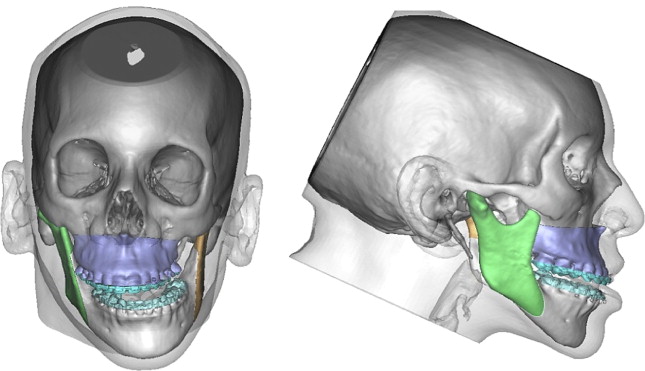
The osteotomies are planned ( Fig. 10 A, B), and in this case a malar implant was virtually constructed to correct the left-sided orbitozygomatic deficiency (see Fig. 10 C). The modeling phase consisted of fabrication of intermediate and final occlusal splints as well as the custom planned cheek implant, all fitted to the stereolithographic model (see Fig. 10 D).
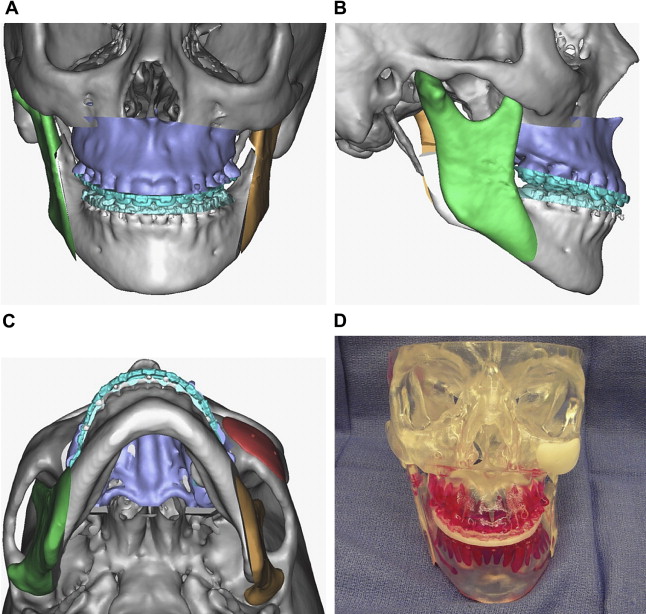
In the surgical phase, the Lefort I and bilateral sagittal split osteotomies are performed as planned, and fixated using the intermediate and final splints. The left-sided malar implant is introduced transorally and fits precisely over the malar prominence without rocking or moving, and is secured with titanium screws through the premilled screw holes. After stable fixation of the maxilla and mandible, the occlusion is noted to be class I as planned. Fig. 11 shows postoperative correction of maxillary cant, midline, vertical excess, and orbitozygomatic deficiency.

In the authors’ experience, virtual treatment planning provides very accurate and predictable results in orthognathic surgery. The ability to visualize skeletal deformities in 3 axes and make reproducible submillimeter movements allows the surgeon to attain the desired outcome. In addition, virtual planning saves a significant amount of preoperative time, as many of the steps in traditional planning have no utility in this model.
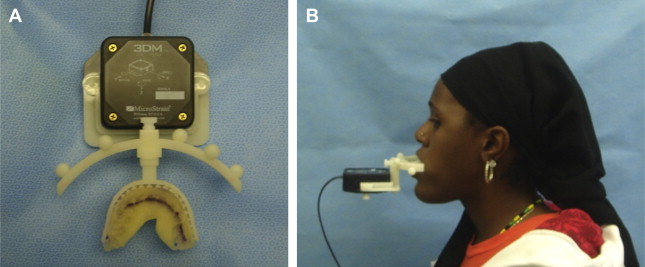
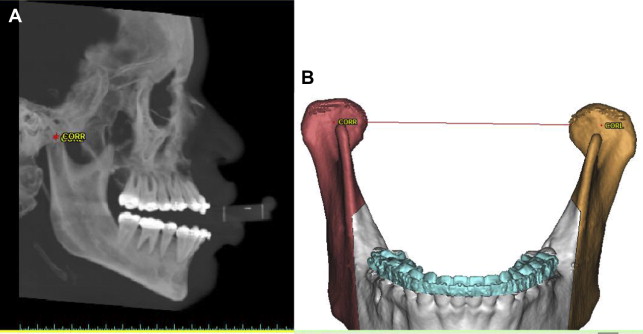
Maxillofacial trauma
Treating complex maxillofacial trauma can be challenging even to experienced surgeons because of severe distortion of anatomy, comminution, and tissue avulsion. When planning surgical correction of a traumatic injury, many factors must be considered:
- •
Status of the dentition
- •
Preexisting occlusal relationship
- •
Facial width and height
- •
Bone segment continuity.
In complex injuries, many or all of these variables are altered, and precise planning is essential for a favorable functional and aesthetic outcome.
There are several approaches to complex trauma described in the surgical literature, and many rely on reduction and fixation of mandibular defects to serve as the template for reducing the rest of the facial bone fractures. Unfortunately many of these complex injuries involve avulsion of teeth, alveolar process fractures, and mandibular comminution; accurate reduction of these fractures is technically difficult. Preoperative planning using dental casts and premade splints based on model surgery may be helpful but only addresses the tooth-bearing bony segments; this is where computer-assisted virtual surgery is beneficial in planning these operations. CT scan of the facial skeleton is acquired in 1-mm cuts, and is sent to Medical Modeling (Golden, CO, USA) along with gypsum dental casts of the maxilla and mandible. Just as previously described for virtual orthognathic surgery, the casts are laser scanned by the modeling company and matrixed into the maxillofacial CT to provide accurate occlusal anatomy for splint fabrication.
Planning of the surgery starts with a Web meeting between the surgical team and biomedical engineer from the modeling company. During the meeting, all participants have access to the 3D reconstructions of the combined CT/laser scan, and can manipulate the fractured segments in the virtual environment to obtain the desired result. This “virtual reduction” significantly reduces the amount of trial-and-error segment manipulation in the operating room, thereby reducing operating time and associated morbidity. The engineer can now design occlusal splints based on the desired reduction to allow for proper alignment and fixation of the maxilla and mandible. Templates for non–tooth-bearing facial bones can be created to allow for proper restoration of facial width and projection. In cases of tissue loss or severe comminution, custom alloplasts can be fabricated to aid in the reconstruction. These surgical guides and alloplastic implants are sent to the surgical team, sterilized, and implemented intraoperatively.
A 39-year-old woman taxicab passenger was hit by an 18-wheeler and suffered a traumatic brain injury as well as multiple facial fractures including frontal sinus, right orbital roof, right zygomatic arch, naso-orbitoethmoid, comminuted LeFort III, palatal, and right mandibular parasymphysis fractures. Her initial management included frontal craniectomy by the neurosurgery team to relieve brain edema.
The planning phase begins with acquiring high-resolution maxillofacial CT images and dental models. These images are sent to the modeling company, and a composite merged 3D reconstruction is created ( Figs. 12 and 13 ). The bony injuries are analyzed in all planes and virtual reduction of the fractures is performed according to the surgeon’s preference—in this case top down, outside in. Volumetric and linear analysis of reduced segments is easily computed by the virtual software to aid in establishing symmetry, facial widths, and facial heights. In complex panfacial trauma, much of this trial-and-error process is completed intraoperatively, resulting in increased operating time and inability to evaluate the final repairs until postoperative imaging is acquired. Using virtual surgery this can take place preoperatively, and the ideal reduction and fixation can be planned to submillimeter increments.
Once the fractures are successfully virtually reduced, planning for replacing lost tissue is addressed. The right orbital bony avulsion is virtually reconstructed with a planned bone graft from the anterior iliac crest ( Fig. 14 A). To successfully recreate the planned surgery, several guides and splints are manufactured in the modeling phase of the virtual surgery. A frontal bandeau guide is fabricated to allow for correction of the upper facial width (see Fig. 14 B). Bilateral lateral orbital guides are manufactured to reestablish orbitomalar width, projection, and contour (see Fig. 14 C). A bone graft template is fabricated to mimic the planned corticocancellous block graft for the right orbit ( Fig. 15 C), and occlusal splints are created to establish the correct maxillomandibular relations in the sagittal and axial planes (see Fig. 14 D).










